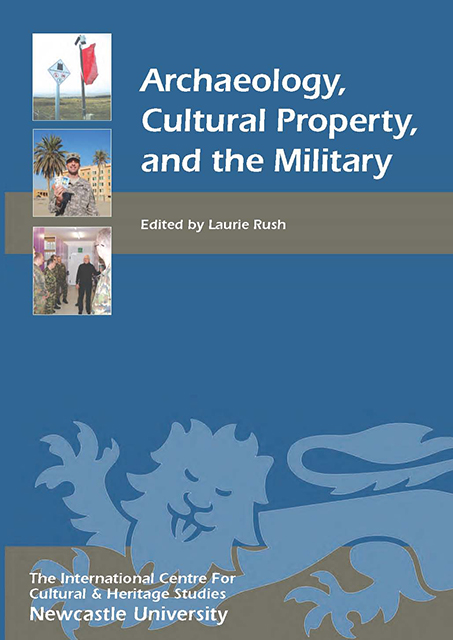Book contents
- Frontmatter
- Contents
- List of Illustrations: Figures and Tables
- Archaeology and the Military: An Introduction
- 1 The Obligations Contained in International Treaties of Armed Forces to Protect Cultural Heritage in Times of Armed Conflict
- 2 Rescuing Europe’s Cultural Heritage: The Role of the Allied Monuments Officers in World War II
- 3 The UK’s Training and Awareness Programme
- 4 US Army Civil Affairs: Protecting Cultural Property, Past and Future
- 5 Cultural Property Protection in the Event of Armed Conflict: Deploying Military Experts or Can White Men Sing the Blues?
- 6 Good Training and Good Practice: Protection of the Cultural Heritage on the UK Defence Training Estate
- 7 In-Theatre Soldier Training through Cultural Heritage Playing Cards: A US Department of Defense Example
- 8 Dealing the Heritage Hand: Establishing a United States Department of Defense Cultural Property Protection Program for Global Operations
- 9 Teaching Cultural Property Protection in the Middle East: The Central Command Historical/Cultural Advisory Group and International Efforts
- 10 Cultural Resources Data for Heritage Protection in Contingency Operations
- 11 Time not on my Side: Cultural Resource Management in Kirkuk, Iraq
- 12 US Military Support of Cultural Heritage Awareness and Preservation in Post-Conflict Iraq
- 13 Operation Heritage
- 14 Cultural Property Protection in the Event of Armed Conflict – Austrian Experiences
- 15 The Role of the Swiss Armed Forces in the Protection of Cultural Property
- 16 Preserving Global Heritage from Space in Times of War
- Appendix 1 1954 Hague Convention and its two Protocols
- Appendix 2 Author Biographies
- Index
2 - Rescuing Europe’s Cultural Heritage: The Role of the Allied Monuments Officers in World War II
Published online by Cambridge University Press: 28 February 2023
- Frontmatter
- Contents
- List of Illustrations: Figures and Tables
- Archaeology and the Military: An Introduction
- 1 The Obligations Contained in International Treaties of Armed Forces to Protect Cultural Heritage in Times of Armed Conflict
- 2 Rescuing Europe’s Cultural Heritage: The Role of the Allied Monuments Officers in World War II
- 3 The UK’s Training and Awareness Programme
- 4 US Army Civil Affairs: Protecting Cultural Property, Past and Future
- 5 Cultural Property Protection in the Event of Armed Conflict: Deploying Military Experts or Can White Men Sing the Blues?
- 6 Good Training and Good Practice: Protection of the Cultural Heritage on the UK Defence Training Estate
- 7 In-Theatre Soldier Training through Cultural Heritage Playing Cards: A US Department of Defense Example
- 8 Dealing the Heritage Hand: Establishing a United States Department of Defense Cultural Property Protection Program for Global Operations
- 9 Teaching Cultural Property Protection in the Middle East: The Central Command Historical/Cultural Advisory Group and International Efforts
- 10 Cultural Resources Data for Heritage Protection in Contingency Operations
- 11 Time not on my Side: Cultural Resource Management in Kirkuk, Iraq
- 12 US Military Support of Cultural Heritage Awareness and Preservation in Post-Conflict Iraq
- 13 Operation Heritage
- 14 Cultural Property Protection in the Event of Armed Conflict – Austrian Experiences
- 15 The Role of the Swiss Armed Forces in the Protection of Cultural Property
- 16 Preserving Global Heritage from Space in Times of War
- Appendix 1 1954 Hague Convention and its two Protocols
- Appendix 2 Author Biographies
- Index
Summary
INTRODUCTION
Throughout history the looting of enemy property in times of war has been an accepted practice. Monuments, works of art and culturally significant objects have always been favoured targets. Not until the 20th century did a more enlightened attitude finally emerge. The most successful large-scale action to rescue and protect cultural property in the 20th century occurred during World War II. British and American fine art advisers were attached to fighting units in the Allied forces in Europe with the express objective of preserving what remained of Europe's great architectural and artistic traditions. This chapter will focus on the history and accomplishments of this extraordinary group of men and women.
INITIAL RESPONSE
In the early 1940s the occupation of Western Europe by Nazi forces led to growing concern, both in Britain and in America, over the protection of works of art and monuments located in the war zones. In the USA, numerous civilian groups were formed at centres of learning. The most prominent of these included a special committee of the American Council of Learned Societies and the American Defense–Harvard Group, which consisted of concerned faculty from Harvard University in combination with local citizenry (Smyth 1988). In response to a request from the War Department, both groups began to prepare lists of art objects and monuments requiring protection in occupied territories or in possible theatres of war.
A four-part report was produced which consisted of lists of monuments and artworks organised by country and included an explanation of the significance of the material, a brief historical outline and a short bibliography. Also included was a brief ‘first aid’ manual outlining principles and practices of safeguarding and preserving cultural material in the field as well as lists of military and civilian personnel experienced in handling cultural material (Perry 1943). This comprehensive document, which included lists for virtually all enemy-occupied countries, was all the more remarkable for the fact that it was completed within eight months by busy museum professionals and academics.
- Type
- Chapter
- Information
- Archaeology, Cultural Property, and the Military , pp. 15 - 27Publisher: Boydell & BrewerPrint publication year: 2010
- 3
- Cited by



